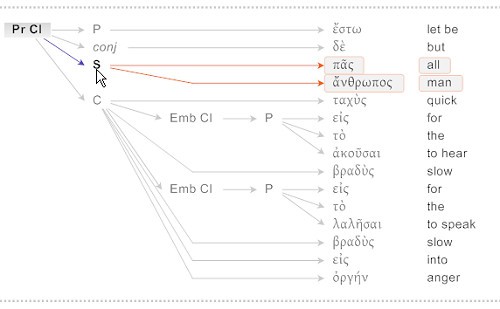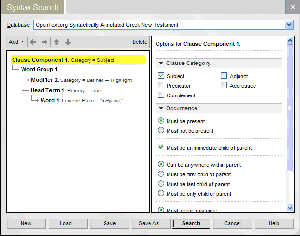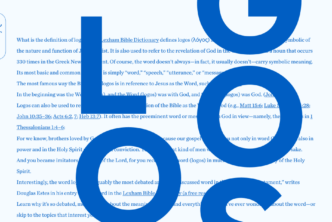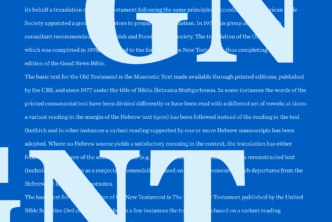I’ve briefly discussed searching OpenText.org material at the word level; this post discusses searching at the clause level, with word group level stuff in the mix.
There’s even a groovy video of the search I describe so you can see exactly what’s going on (see bottom of this article). One take, no cuts. This is done with the current beta version of Logos Bible Software (3.0 Beta 1) and an extra syntax searching component currently in development.
I’m looking at James 1.19, specifically ??? ????????. If I’m interested in searching further on the use of the term ???????? in similar situations, one approach is to search for the lexical form ???????? and see what happens. But there are over 500 instances of this, and I’d rather not filter through the list. I could search for combinations of lexical forms ??? and ???????? in proximity, but that ties me to using ??? to further define ????????, and I’m interested in the general definition relationship, not specifically the term “all people” or “all men”. For instance, what about “no men”? Or “some people”?
This is where the OpenText.org Analysis shines. If I consult the Word Analysis, I note that ??? functions as a definer, modifying ???????? in a particular manner. This relationship can be queried. But that’s not all if I consult the Clause Analysis, I see that ??? ???????? is the subject of the clause.
This means that I can search for a Subject clause component that contains a word group that specifies a modification relationship between a definer and the head term ????????. I am creating a tree-like structure, much like that of the syntax graph, to query the syntax information for the sort of thing I’m looking for. Like the image below. Compare the syntax graph structure with the structure implied by the levels and arrows in the query dialog (left pane of the search dialog).
Instead of 500+ instances to examine, one now has 25 instances to work through. A video of the specification, search, and display of some results is available as a video presentation (1024×768, Flash, approx. 1.5 megs).
Note particularly the Syntax Search Results window displayed in the video. The Greek text is in the middle column. The shaded background represents the extent of the structure found in this case, the extent of the subject clause component. The red text is text that was specified for “highlighting” in the search dialog (watch the video again, you’ll see me check the option after specifying the modifier).
The column on the right is the text of the English Standard Version (ESV) New Testament that has been aligned with the Greek on a word-by-word basis. The search hit highlighting means the same thing in that column.
Please take careful note of this. We specified a search of the Greek syntactic structure, along with Greek words. Those hits were found in the Greek text. But because of alignment work we’ve done, we can now represent those hits in Greek and in English, at the word level. Yes, we’re doing similar work in the Hebrew, though it has not quite matured to the point that the Greek has (hey, the Hebrew Bible is 3x bigger than the Greek NT!)
When the text in the ESV column is clicked, the search hit is retrieved and displayed in the ESV New Testament Reverse Interlinear. You can see the same highlighting taking place; shaded background representing the extent of the subject clause component; red text indicating the “highlighted” term, in this case the modifier. In this search, the various terms that modify the head term ???????? as preceding definers are red. Items like “all” men, “which” people, “every” person and the like are the sorts of things that are located with this search.
Video: 1024×768, Flash, approx. 1.5 megs.
Let us know what you think!






